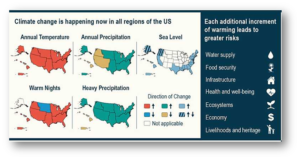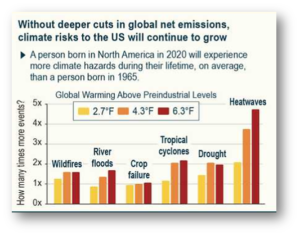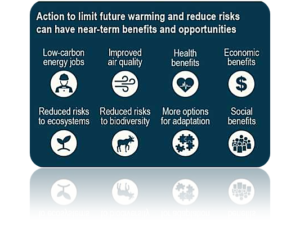Five Takeaways from Sweeping US Climate Report
“The impacts of climate change are continuing to change faster than we expected them to.”
It’s increasing the urgency for both mitigating greenhouse gases and also implementing adaptation efforts to help us adapt, because we’re not slowing down [warming] anytime soon”… Kris May, Chief executive officer of Pathways Climate Institute in San Francisco.
 A Fifth National Climate Assessment report issued today by the US government describes how intensifying climate change is disrupting lives and businesses nationwide, even as communities in every state ramp up their response to the crisis: https://www.whitehouse.gov/briefing-room/statements-releases/2023/11/14/fact-sheet-biden-harris-administration-releases-fifth-national-climate-assessment-and-announces-more-than-6-billion-to-strengthen-climate-resilience-across-the-country/
A Fifth National Climate Assessment report issued today by the US government describes how intensifying climate change is disrupting lives and businesses nationwide, even as communities in every state ramp up their response to the crisis: https://www.whitehouse.gov/briefing-room/statements-releases/2023/11/14/fact-sheet-biden-harris-administration-releases-fifth-national-climate-assessment-and-announces-more-than-6-billion-to-strengthen-climate-resilience-across-the-country/
The over 2,000 page report offers a climate-themed tour of the country, identifying the impacts plaguing every region, how communities are increasingly protecting themselves and how much more action is needed to ensure a safer future. The fifth edition of the report follows the fourth edition, which was published in phases in 2017 and 2018; the first assessment appeared in 2000.
Here are the five main takeaways:
- Climate impacts are here, getting worse and costing a lot of money
The first sentence of Chapter 1 summarizes the nation’s sobering reality: “The effects of human-caused climate change are already far-reaching and worsening across every region of the United States.” A small taste of what that means: Warming is happening everywhere, and nighttime temperatures are rising faster than daytime temperatures in most places.
 Minor and moderate coastal flooding is also on the rise along most Atlantic and Gulf coastlines, while a combination of rising seas and flooding from high tides and big storms is projected for the the mid-pacific and Hawaiian island chain. Meanwhile, warmer winters are contributing to declining snowpack levels in the Northwest, affecting water supplies.
Minor and moderate coastal flooding is also on the rise along most Atlantic and Gulf coastlines, while a combination of rising seas and flooding from high tides and big storms is projected for the the mid-pacific and Hawaiian island chain. Meanwhile, warmer winters are contributing to declining snowpack levels in the Northwest, affecting water supplies.
But the most devastating way people experience climate change is in the form of major disasters. Between 2018 and 2022, the country experienced 89 disasters that each cost at least $1 billion in damages — a mix of droughts, floods, severe storms, tropical cyclones, wildfires and winter storms. During that period, Texas alone experienced $375 billion in disaster damages.
- Certain communities are at higher risk
No one living in the US is safe from climate change, but low-income communities and people of color are disproportionately at risk of experiencing damaging impacts. In the South, for example, neighborhoods home to racial minorities and low-income people have the highest inland exposure to flooding, concludes the report. Moreover, the report adds, “Black communities nationwide are expected to bear a disproportionate share of future flood damages — both inland and coastal.”
- Climate solutions are already being deployed nationwide
Knowing the source of the problem (emissions from burning fossil fuels) means we also know how to stop it: by transitioning from fossil fuels to cleaner forms of energy, and possibly by using a mix of natural and manmade processes to pull carbon dioxide and other emissions directly out of the air.
Efforts are already well underway. “Annual US greenhouse gas emissions fell 12% between 2005 and 2019,” largely due to natural gas replacing coal for some electricity generation, the report states. Between roughly 2010 and 2022, cumulative onshore wind capacity, utility-scale solar and EV sales have all gone up nationwide as costs associated with these low-carbon technologies have dropped.
Homes with rooftop solar panels in Rocklin, California. Photographer: David Paul Morris/Bloomberg
- Today’s efforts aren’t nearly enough to halt a global climate crisis
Back in 2015, the US joined the Paris Agreement, agreeing to limit future global warming to well below 2C, ideally to 1.5C, compared to preindustrial levels. President Joe Biden then set a national target for the US to cut its emissions by at least 50% by 2030 compared to 2005 levels. Now the reality check: The world is on track to warm above 2C, in part because the US — the second-biggest current emitter and largest historical emitter — is not on pace to meet its goals.
US net emissions would have to fall by more than 6% each year on average to meet existing targets, according to the report. In contrast, US emissions fell by less than 1% per year, on average, between 2005 and 2019.
- What now? It depends on us …
 The more warming there is, the worse the impacts will be. Science can’t tell us exactly how hot the planet will get because that depends on what we — society as a whole but especially our political leaders — decide to do. In the US, and elsewhere in the world, people have a choice right now to do more to cut their carbon footprint and prevent much worse warming.
The more warming there is, the worse the impacts will be. Science can’t tell us exactly how hot the planet will get because that depends on what we — society as a whole but especially our political leaders — decide to do. In the US, and elsewhere in the world, people have a choice right now to do more to cut their carbon footprint and prevent much worse warming.
“How much more the world warms depends on the choices societies make today,” states the report. “The future is in human hands.”




Leave a Reply
Join the Community discussion now - your email address will not be published, remains secure and confidential. Mahalo.